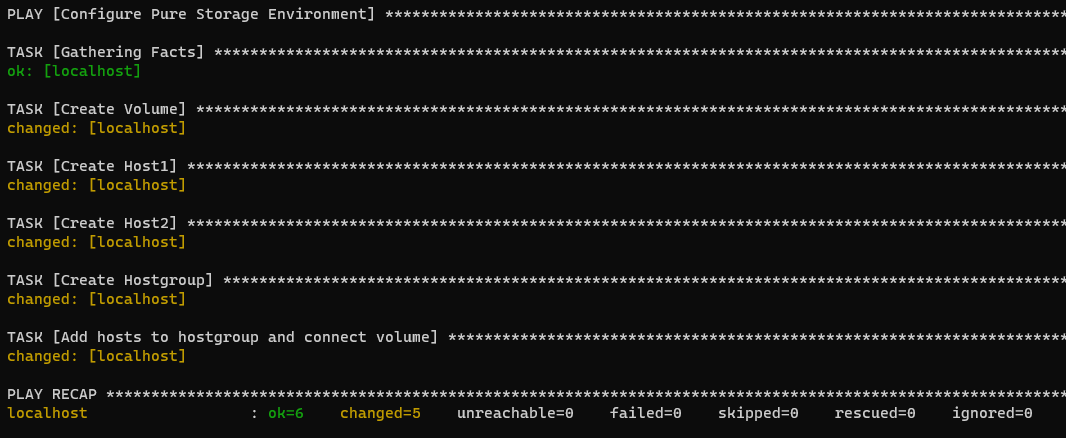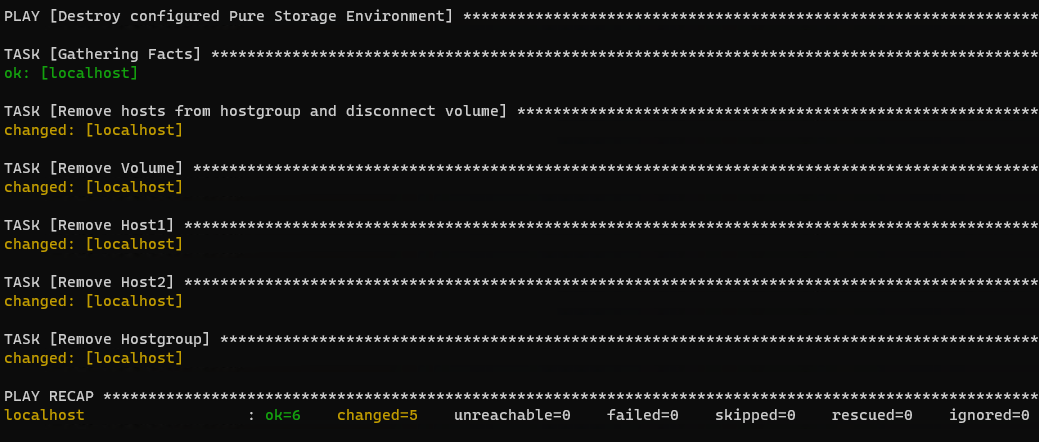- Using Ansible to Provision your Pure Storage Infrastructure
Using Ansible to Provision your Pure Storage Infrastructure
I mentioned previously that there are many things I love about the Pure Storage Flasharray, but one of my favorite is how easy it is to integrate into different automation solutions. In this blog I will cover how to use Ansible to provision your Pure Storage Infrastructure.
Information on the Pure Storage Ansible Integration
The official site has information on the integration and the documentation is a great place on how to learn to use the integration. Are you looking for examples? Then checkout GitHub.
Installing and Setting up the Ansible Integration
- Install Python
- Install Ansible
- Install Pure Storage Python package by running pip install purestorage
- Install Pure Storage Ansible Provider by running ansible-galaxy collection install purestorage.flasharray
Using Ansible to Provision your Pure Storage Infrastructure
Below is a sample ansible playbook that will create a volume, two hosts with an ISCSI iqn and then add the hosts and volume to a hostgroup.
1- name: Configure Pure Storage Environment
2 hosts: localhost
3 collections:
4 - purestorage.flasharray
5 gather_facts: yes
6 vars:
7 fa_url: 192.168.1.10
8 fa_api_token: apitokenhere-00000000
9 tasks:
10 - name: Create Volume
11 purefa_volume:
12 name: david-ansible-test
13 size: 10G
14 fa_url: "{{fa_url}}"
15 api_token: "{{fa_api_token}}"
16 - name: Create Host1
17 purefa_host:
18 host: "david-ansible-host1"
19 protocol: iscsi
20 iqn: "iqn.1998-01.com.vmware:david-ansible-host1"
21 fa_url: "{{fa_url}}"
22 api_token: "{{fa_api_token}}"
23 - name: Create Host2
24 purefa_host:
25 host: "david-ansible-host2"
26 protocol: iscsi
27 iqn: "iqn.1998-01.com.vmware:david-ansible-host2"
28 fa_url: "{{fa_url}}"
29 api_token: "{{fa_api_token}}"
30 - name: Create Hostgroup
31 purefa_hg:
32 hostgroup: david-ansible-hostgroup
33 fa_url: "{{fa_url}}"
34 api_token: "{{fa_api_token}}"
35 - name: Add hosts to hostgroup and connect volume
36 purefa_hg:
37 hostgroup: david-ansible-hostgroup
38 host:
39 - "david-ansible-host1"
40 - "david-ansible-host2"
41 volume: "david-ansible-test"
42 fa_url: "{{fa_url}}"
43 api_token: "{{fa_api_token}}"
Using Ansible to Cleanup your Pure Storage Infrastructure
Below is a sample ansible playbook that will destroy the volume, hosts and hostgroup that were previously created. Don’t forget to update your fa_url and fa_api_token variables.
1- name: Destroy configured Pure Storage Environment
2 hosts: localhost
3 collections:
4 - purestorage.flasharray
5 gather_facts: yes
6 vars:
7 fa_url: 192.168.1.10
8 fa_api_token: apitokenhere-00000000
9 tasks:
10 - name: Remove hosts from hostgroup and disconnect volume
11 purefa_hg:
12 hostgroup: david-ansible-hostgroup
13 host:
14 - "david-ansible-host1"
15 - "david-ansible-host2"
16 volume: "david-ansible-test"
17 fa_url: "{{fa_url}}"
18 api_token: "{{fa_api_token}}"
19 state: absent
20
21 - name: Remove Volume
22 purefa_volume:
23 name: david-ansible-test
24 fa_url: "{{fa_url}}"
25 api_token: "{{fa_api_token}}"
26 state: absent
27 eradicate: false
28
29 - name: Remove Host1
30 purefa_host:
31 host: "david-ansible-host1"
32 fa_url: "{{fa_url}}"
33 api_token: "{{fa_api_token}}"
34 state: absent
35
36 - name: Remove Host2
37 purefa_host:
38 host: "david-ansible-host2"
39 fa_url: "{{fa_url}}"
40 api_token: "{{fa_api_token}}"
41 state: absent
42
43 - name: Remove Hostgroup
44 purefa_hg:
45 hostgroup: david-ansible-hostgroup
46 fa_url: "{{fa_url}}"
47 api_token: "{{fa_api_token}}"
48 state: absent
Running your Ansible Playbook
The examples above can be found here
To configure your infrastructure run:
1ansible-playbook ./StorageConfiguration.yaml
To cleanup the infrastructure we configured run:
1ansible-playbook ./DestroyStorageConfiguration.yaml
Its that easy!
Closing
Ansible is a great tool when it comes to automation! Its extensibility across multiple platforms and integrations makes it an ideal candidate for use in many environments.
Any questions or comments? Leave them below.
comments powered by Disqus
